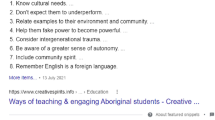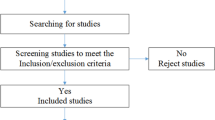Abstract
With increasing numbers of students learning science through a second language in many school contexts, there is a need for research to focus on the impact language has on students’ understanding of science concepts. Like other countries, Brunei has adopted a bilingual system of education that incorporates two languages in imparting its curriculum. For the first three years of school, Brunei children are taught in Malay and then for the remainder of their education, instruction is in English. This research is concerned with the influence that this bilingual education system has on children’s learning of science. The purpose was to document the patterns of Brunei students’ developing understandings of the concepts of living and non-living things and examine the impact in the change in language as the medium of instruction. A cross-sectional case study design was used in one primary school. Data collection included an interview (n = 75), which consisted of forced-response and semi-structured interview questions, a categorisation task and classroom observation. Data were analysed quantitatively and qualitatively. The results indicate that the transition from Malay to English as the language of instruction from Primary 4 onwards restricted the students’ ability to express their understandings about living things, to discuss related scientific concepts and to interpret and analyse scientific questions. From a social constructivist perspective these language factors will potentially impact on the students’ cognitive development by limiting the expected growth of the students’ understandings of the concepts of living and non-living things.
Similar content being viewed by others
References
Ali Hashim, D. (2001). Speech for the opening ceremony of the sixth annual International Conference of Science and Mathematics Education. Bandar Seri Begawan.
Angus, J. W. (1981). Children’s conceptions of the living world. Australian Science Teachers’ Journal, 27(3), 65–68.
Baker, C. (2001). Foundations of bilingual education and bilingualism. Clevedon, UK: Multilingual Matters.
Bell, B. F. (1981). When is an animal, not an animal? Journal of Biological Education, 15(3), 213–218.
Bell, B. F., & Freyberg, P. (1985). Language in the science classroom. In R. Osborne & P. Freyberg (Eds.), Learning in science: The implications of children’s science (pp. 29–40). Portsmouth, NH: Heinemann.
Boudourides, M. A. (1998, July). Constructivism and education: A shopper’s guide. Paper presented at the International Conference on the Teaching of Mathematics, Samos, Greece.
Briner, M. (1999). Constructivism. Retrieved April 6, 2001, from http://curriculum.calstatela.edu/faculty/psparks/theorists/501const.html.
Buck, J. A., Dent, E. B., & Umpleby, S. A. (2000). Communicating science: The difficulty introduced by the historical politics of the English language. Science Communication, 22(1), 73–87.
Burns, R. B. (2000). Introduction to research methods (4th ed.). Selangor Durul Ehsan, Malaysia: Longman.
Carey, S. (1985). Conceptual change in childhood. Cambridge, MA: MIT Press.
Clerk, D., & Rutherford, M. (2000). Language as a confounding variable in the diagnosis of misconceptions. International Journal of Science Education, 22(7), 703–717.
Cohen, L., Manion, L., & Morrison, K. (2000). Research methods in education (5th ed.). London: Routledge/Falmer.
Davies, P. (2000). Brunei language education. Asian Analysis. Retrieved February 5, 2006, from http://www.aseanfocus.com.
Diolata, O. (2001, 4 September). Science subjects give students a headache. News Express, p. 2.
Gallimore, R., & Tharp, R. (1990). Teaching mind in society: Teaching, schooling and literate discourse. In L. C. Moll (Ed.), Vygotsky and education (pp. 175–205). Cambridge, UK: Cambridge University press.
Heppner, F. H., Heppner, M. C., & Leong, Y. P. (1997). Teachers’ estimates of, and measurements of students’ reading ability, and readability of text materials in an English as a second language secondary biology course. Journal of Applied Research in Education, 1(2), 31–39.
Hewson, M. G., & Hamyln, D. (1983, April). The influence of intellectual environment on conceptions of heat. Paper presented at the annual meeting of the American Educational Research Association, Montreal, Canada.
James, C. (1996). Mother tongue use in bilingual/bidialectal education: Implications for Bruneian dwibahasa. Journal of Multilingual and Multicultural Development, 17(2–4), 248–257.
Jones, G. M. (2000a). Some language planning questions facing Brunei Darussalam, Singapore, Malaysia and the Philippines. In M. L. S. Bautista, T. A. Llamzon & S. B. Sibayan (Eds.), Parangal cang [A tribute from] Brother Andrew Festschrift for Andrew Gonzalez on his sixtieth birthday (pp. 226–238). Manila, Philippines: Linguistic Society of the Philippines.
Jones, G. M. (2000b). Bilingualism and biliteracy in Brunei Darussalam: Interpretation and future directions. In C. L. Clern (Ed.), Issues in Asian literacy. Newark, DE: International Reading Association.
Jones, G. M. (2000c). Bilingual education and syllabus design: Towards a workable blueprint. In D. R. Hall & A. Mewings (Eds.), Innovation in English teaching (pp. 99–107). London: Routledge.
Kaplan, R. B., & Baldauf, R. B. Jr. (1997). Language planning: From practice to theory. Clevedon, UK: Multilingual Matters.
Kearsey, J., & Turner, S. (1999). The value of bilingualism in pupils’ understanding of scientific language. International Journal of Science Education, 21(10), 1037–1050.
Laurendeau, M., & Pinard, A. (1962). Causal thinking in the child: A genetic and experimental approach. New York: International Universities Press.
Lim, S. B., Suntharalechmy, K., & Salleh, R. (1999). Science achievement in primary schools in Brunei Darussalam: A pilot study. In K. Y. Wong (Ed.), CARE review 1999 (pp. 53–57). Gadong, Brunei: University Brunei Darussalam.
Martin, P. W. (1999). Close encounters of a bilingual kind: International practices in the primary classroom in Brunei. International Journal of Educational Development, 19, 127–140.
Merriam, S. B. (1998). Qualitative research and case study applications in education. San Francisco: Jossey-Bass.
O’Toole, M. (1996). Science, schools, children and books: Exploring the classroom interface between science and language. Studies in Science Education, 28, 113–143.
Piaget, J. (1929). The child’s conception of the world. London: Routledge and Kegan Paul.
Rincon, E., & Ray, R. (1974). Bilingual ethnic teachers an answer to illiteracy and drop-out problems. Reading Improvement, 11(1), 34–36.
Rollnick, M. (1998). The influence of languages on the second language teaching and learning of science. In W. W. Cobern (Ed.), Socio-cultural perspectives on science education: An international dialogue (pp. 121–137). London: Kluwer Academic.
Siegal, M., & Peterson, C. C. (1999). Becoming mindful of biology and health: An introduction. In M. Siegal & C. C. Peterson (Eds.), Children’s understanding of biology and health. Cambridge, UK: Cambridge University press.
Tema, B. O. (1989). Rural and urban African pupils’ alternative conceptions of ‘animal’. Journal of Biological Education, 23(3), 199–207.
The Learning Network (2001). Brunei Darussalam. Retrieved March 25, 2001, from http://www.sg/flavour/profile/pro-f_singapore1.html.
Tobin, K. (1993). The practice of constructivism in science education. Washington, DC: American Association for the Advancement of Science Press.
Torres, H. N. (2000). A study of the effects of English language proficiency and scientific reasoning skills on the acquisition of science content knowledge of Hispanic English language learners and native English language-speaking students participating in Grade 10 science classes. Dissertation Abstract International, A: The Humanities and Social Sciences, 61(2), 554-A.
Towbridge, J. E., & Mintzes, J. J. (1988). Alternative conceptions in animal classification: A cross-age study. Journal of Research in Science Teaching, 25(7), 547–571.
Venville, G. J. (2004). Young children learning about living things: A case study of conceptual change from ontological and social perspectives. Journal of Research in Science Teaching, 41(5), 449–480.
Venville, G. J., Adey, P. L., Larkin, S., & Robertson, A. (2003). Fostering thinking through science in the early years of schooling. International Journal of Science Education, 25(11), 1313–1331.
Villalbi, R. M., & Lucas, A. M. (1991). When is an animal not an animal? When it speaks English. Journal of Biological Education, 25(3), 184–186.
Vygotsky, L. (1986). Thought and language. London: MIT Press.
Weirsma, W. (1986). Research methods in education: An introduction (4th edition). Boston, MA: Allyn and Bacon.
Wertsch, J. V. (1990). The voice of rationality in a sociocultural approach to mind. In L. C. Moll (Ed.), Vygotsky and education (pp. 111–126). Cambridge, UK: Cambridge University Press.
Wertsch, J. V., & Toma, C. (1995). Discourse and learning in the classroom: A socio-cultural approach. In L. P. Steffe & J. Gale (Eds.), Constructivism in education (pp. 159–174). Hillsdale, MI: Lawrence Erlbaum.
Author information
Authors and Affiliations
Corresponding author
Additional information
A paper accepted by Research in Science Education, August, 2006.
Rights and permissions
About this article
Cite this article
Salleh, R., Venville, G.J. & Treagust, D.F. When a Bilingual Child Describes Living Things: An Analysis of Conceptual Understandings from a Language Perspective. Res Sci Educ 37, 291–312 (2007). https://doi.org/10.1007/s11165-006-9027-4
Received:
Accepted:
Published:
Issue Date:
DOI: https://doi.org/10.1007/s11165-006-9027-4




